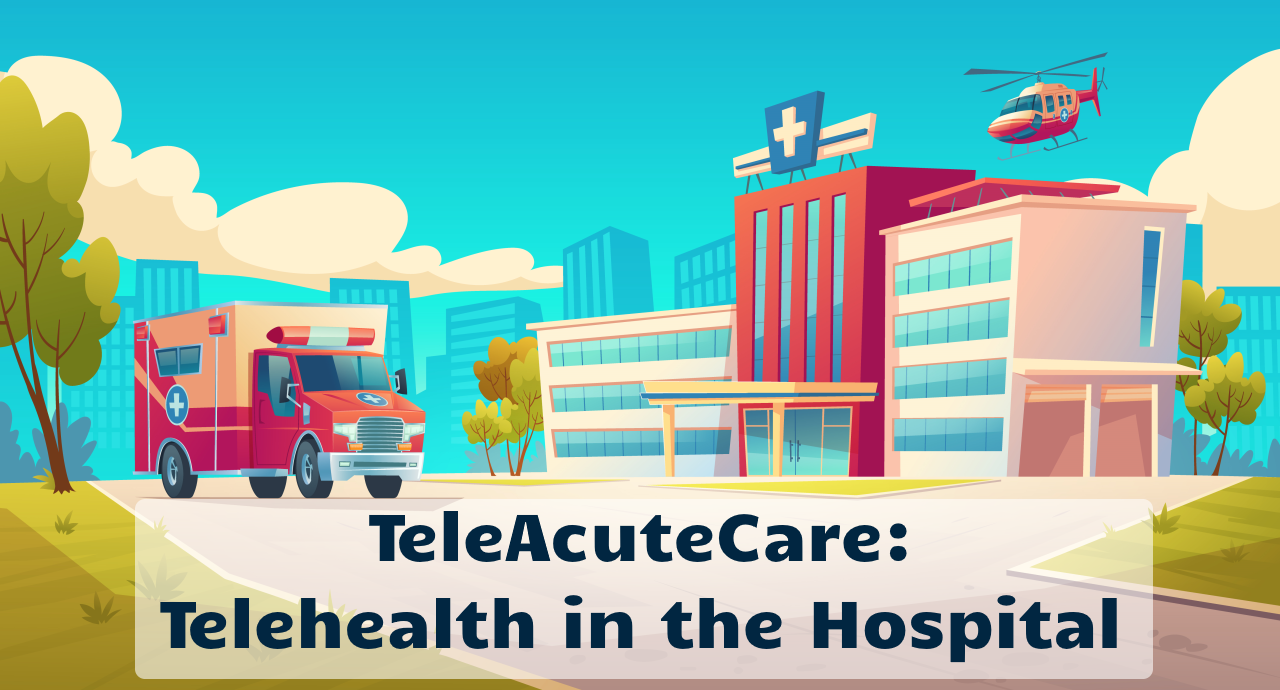In the middle of the Covid-19 health crisis most of us think of telehealth as a way to keep people out of the clinic environment, out of the hospital. But there are a number of excellent use cases for using telehealth with patients in an acute care situation. They include:
- TeleRadiology, TeleEEG
- TeleTriage/Evaluation
- TeleStroke/TeleNeurology
- TelePsychiatry
- TeleHospitalist
- Virtual Rounding
- Remote Check In / Monitoring
- TeleICU (or eICU)
TeleRadiology
The first use case on the list is TeleRadiology and it’s almost easy to forget about it. TeleRadiology is the capability to transmit radiological studies — x rays, CT scans, MRI scans — and send them to an offsite (sometimes offshore) radiologist for review. TeleRadiology has been alive and well for well over 25 years and was such a quiet and resounding success that for the past 15 years basically nobody has talked about it anymore – and it does not even come up when people talk about telehealth.
Telehealth in the ER
This next set of use cases plays a critical role in the ER. Especially during the Covid-19 health crisis, the ER oftentimes emerges as the first bottleneck when infections and admissions spike. Ensuring rapid proper triage and disposition (admit to hospital? send back home? refer to nursing home?) is key to maintain sufficient capacity to deal with the increasing influx of new patients.
TeleTriage, TeleEvaluation is not an acute care telehealth service per se. Unlike the other scenarios listed here, we don’t even expect the patient to be within the hospital wall. TeleTriage, in the context of an Emergency Room, is basically the concept of using video-based interactive patient care solutions to connect with patients before they arrive at the emergency room. The calls can originate from a number of locations – from the patients’ home using the emergency room’s web page; from associated urgent care centers that can connect patients directly to the nearest ER for an admission consultation; or from area nursing homes, especially after hours or before or on weekends; etc.
After connecting with the patient, a clinician can quickly walk the patient through a number of assessments to determine whether the patient is best served by presenting to the Emergency Room.
TeleStroke is right after TeleRadiology, another one of the most common telehealth use cases. It took off about 15 years ago, especially due to the rapid adoption of administering tPA for ischemic strokes (“use of tPA for ischemic strokes nearly doubled from 2003 to 2011”).
In Telestroke a neurologist is quickly connected virtually with a patient that is suspected of experiencing a stroke. In conjunction with the hospital staff and direct access to the CT scan of the patient’s brain to establish whether the administration of tPA is indicated. There are even a few TeleStroke-optimized telehealth solutions available that present the neurologist with critical information, e.g., such as the time from onset of symptoms, since the administration of tPA is only safe within a certain time frame.
Another neurological telehealth service that is related to TeleStroke and TeleRadiology is Especially in the emergency room environment it is becoming an increasingly important diagnostic tool. Similar to a radiology study, once acquired, an electroencephalogram can be sent electronically to an offsite neurologist to interpret the EEG and report back the findings typical within 30 minutes.
TelePsychiatry — while we think of TeleMentalHealth services mostly in the context of home-based counseling or psychiatric help, there are actually circumstances where 24×7 and especially weekend access to a mental health professional can have big implications for the emergency room.
When patients are deemed psychologically unstable, they cannot be discharged but also cannot be admitted to the hospital and need to be held, oftentimes overnight, in one of the ER rooms. A TelePsychiatrist can conduct a remote assessment and evaluation to determine the best course of action, either clearing the patient to go home, to be admitted to a psychiatric unit, etc. This greatly enhances the ER’s ability to maintain sufficient room capacity and allow the enforcement of physical distancing policies.
Telehealth in the ICU
An eICU (or TeleICU) is the ability for remote critical care staff to remotely supervise ICU patients and work with the local ICU team to handle emergency situations, e.g., when patients crash. A TeleICU differs from the other telehealth applications in that it is not only a 2-way video connection, the remote team also has access to all of the patients’ real-time vital signs and other indicators of their health. Oftentimes setups include multiple cameras with pan-tilt-zoom capabilities for the remote care team to fully participate in emergencies.



Telehealth on the Hospital Floor
Similar to the ER environment, the hospital offers numerous scenarios where telehealth solutions can greatly enhance timely access to care and keep staff and patients safe during the Covid-19 health crisis.
The first set of telehealth use cases provides bedside access to specialty expertise. This can include subspecialty expertise such as a TeleNeurologist, TeleCardiologist or even a TelePsychiatrist or TelePsychologist for the required psychological evaluations or consults on psychiatric medications. More commonly also are now TeleHospitalists, providing smaller hospitals with 24×7 coverage if needed.
For these TeleVisits, a TelePresenter (i.e., a clinical, trained person, e.g., an MA) can bring a cart next to the patient’s bed and initiate a consult between the specialist and the patient, potentially even aiding in an exam using the telemedicine cart’s exam tools.
Historically, access to these remote specialists was only provided outside of normal business hours or on weekends to supplement the onsite staff. During Covid-19, keeping clinical workers as much physically distanced from patients is a desirable goal as transmission of the coronavirus remains high.
Aside from access to specialty expertise, there are two additional use cases that have found great use in response to the Covid-19 crisis: Virtual Rounding and Virtual Check-Ins/Monitoring.
Virtual Rounding enables clinicians to safely participate in hospital rounding without the need to don PPE equipment or even to be in the same facility. E.g., when key clinical leaders have to self-quarantine, they can still participate remotely in the care of the patients. Typically staff will push a cart with the rounding team, allowing all remote participants to interact with the patient as well as to interact with the care team.
Virtual Check-Ins/Monitoring are a fabulous use case necessitated by the health crisis and the need for vigilance and PPE. It describes the capability to “check-in” with the patients via the patient’s in-room TV or other monitor for interactive 2-way conversations or basic monitoring (e.g., to prevent falls). Just recently Banner Health started installing nearly 1,000 virtual check-in units in patient rooms to provide for a safe way for the care team — including the nurses — to care for the patient without the need for PPE.
Telehealth in the Hospital
Hospital Telehealth can help hospitals to deliver extraordinary care while keeping staff and patients safe during this pandemic.
What telehealth use case have you implemented at your hospital? Are you doing any Virtual Rounding or Virtual Check-Ins? Contact me or let me know in the comments below.








To receive articles like these in your Inbox every week, you can subscribe to Christian’s Telehealth Tuesday Newsletter.
Christian Milaster and his team optimize Telehealth Services for health systems and physician practices. Christian is the Founder and President of Ingenium Digital Health Advisors where he and his expert consortium partner with healthcare leaders to enable the delivery of extraordinary care.
Contact Christian by phone or text at 657-464-3648, via email, or video chat.







Leave A Comment